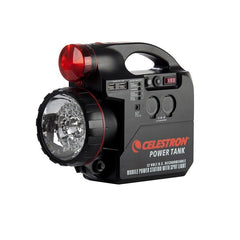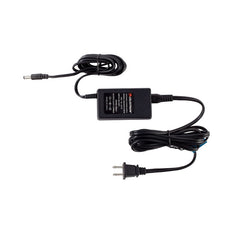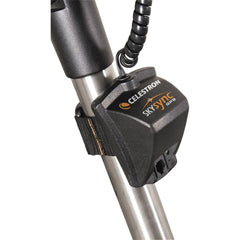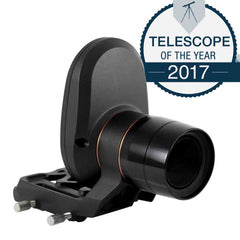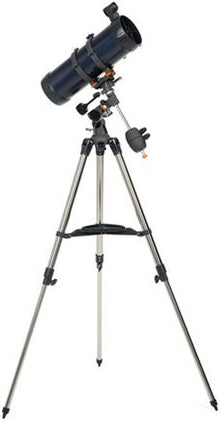Celestron Power Tank 7A 12V Power Supply - 18774
-
Description
For planetary imaging and brighter deep-sky objects, many astroimagers say there’s no better choice than a refractor. Unlike Schmidt-Cassegrain or Newtonian telescopes that have a secondary mirror, refractors offer no obstruction of the aperture, giving you the highest possible contrast. This refractor setup features an f/8 objective lens, which can be paired with one of our Nightscape CCD cameras to image brighter deep-sky objects or our NexImage 5 Solar System Imager to create dazzling images of the planets.
About the Mount
The new Advanced VX mount was specifically designed to provide optimum imaging performance for smaller telescopes. Now your smaller telescope can take advantage of All-Star Polar Alignment and autoguider support. You’ll be able to track through long exposures using permanently programmable periodic error correction. Image across the meridian without doing a meridian flip, so you can seamlessly image the best part of night sky. Advanced VX features significantly larger base castings than our previous design, improving stability under heavier loads. Improved motors offer more torque and can handle slight load imbalances with ease.
- 6” (150mm) f/8 objective lens is perfect for high contrast planetary views
- 2” Focuser allows use with 2” and 1.25” accessories
- Integer gear ratios and permanently programmable Periodic Error Correction eliminates recurring track errors from the worm gear.
- Autoguider port for long exposure imaging
- New motors offer improved tracking performance & provide more power to overcome load imbalances
- Updated industrial design offers more rigidity, less flexure and improved aesthetics
- New design allows viewing or imaging across the meridian without interference from the motors housings
- Improved latitude range. Can be used between 7 – 77 degrees latitude.
- NexStar+ hand control offers multiple language programming (English, French, Italian, German, Spanish)
About Celestron Refractor Telescopes
Celestron’s high-quality refractor telescopes allow beginners to improve upon Galileo’s vision with a simple, reliable design that is easy to use, requires minimal maintenance, and is versatile enough for land or sky viewing. Known for viewing planetary detail and splitting close double-stars.
A refractor telescope uses a lens as the primary. The lens at the front of the telescope bends the light passing through it until it comes to a single point called the “focal plane”. The long, thin tubes of refractor telescopes look much the same as those Galileo used centuries ago. High quality optical glass and multi-coatings provide today’s sky watchers views Galileo never dreamed of.
The refractor type of telescope is very popular with individuals who want mechanical simplicity, rugged reliability and ease of use. Because the focal length is limited by the length of the tube, refractor telescopes become quite bulky and expensive beyond a four inch aperture. This limits the light gathering properties of refractor telescopes, but it is an excellent choice for beginners and those who prefer simple operation and versatility. Refractor telescopes are also a popular choice because of their unobstructed view, high contrast and good definition.
Refractor Advantages- Easy to set-up and use
- Simple and reliable design requires little or no maintenance
- Excellent for lunar, planetary and binary star observing especially in larger apertures
- Good for terrestrial viewing
- High contrast images with no secondary mirror or diagonal obstruction
- Color correction is good in achromatic designs and excellent in apochromatic and fluorite designs
- Sealed optical tube reduces image-degrading air currents and protects optics
- Objective lens is permanently mounted and aligned
Refractor Disadvantages
- More expensive per inch of aperture than Newtonians or Catadioptrics
- Heavier, longer and bulkier than equivalent aperture Newtonians and Catadioptrics
- The cost and size factors limit the practical maximum size primary to smaller apertures
- Some color aberration in achromatic designs (doublet)
All-Star Polar Alignment Technology
German Equatorial Mounts (GEM) have long since been recognized as the mount of choice for astrophotography. Needing to track in only one axis for long exposures; adjustable counterweights and tube position for perfect balance, the GEM has few short comings when it comes to imaging. In order to do long-exposure astro-imaging, an equatorially aligned telescope is needed to allow your telescope to properly track the motion of the sky. However accurate tracking still depends on an accurate polar alignment. Even with a visible star very near the North Celestial Pole (NCP), the true celestial pole can be a very elusive place to find without assistance.Now select Celestron mounts can utilize a new innovative Polar alignment procedure called All-Star™. All-Star allows users to choose any bright star, while the software calculates and assists with polar alignment.
Here's how it works.
Once your telescope is aligned with two bright star, All-Star allows you to choose any bright star listed in the NexStar hand control to assist in accurately aligning your telescope's mount with the North Celestial Pole. Using the telescope's Sync function, the mount is able to point and center a bright star with a high degree of accuracy. Once centered, the mount will point the telescope to the exact position that the star should be if the mount were precisely polar aligned. By simply adjusting the mounts altitude and azimuth controls to re-center the star in the center of the eyepiece, you are actually moving the mounts polar axis to the exact position of the North Celestial Pole.
FAQ's
Can I use Polaris to polar align my telescope?
Since Polaris is very close to the NCP and not very bright, it is actually not a recommended star for the "All-Star" method. The advantages of being able to use stars other than Polaris are two fold:Polaris is not always visible. So not only can you use a variety of other stars but they are also brighter and more prominent.
The star you choose will be farther away from the NCP thus allowing for greater accuracy when centering the star in your eyepiece.Which stars are best to use for polar aligning?
For best results choose a bright alignment star that is near the Meridian, preferably close to the celestial equator. Try to avoid stars that are close to the west/east horizon or directly overhead because they can be more difficult to center using the mount's altitude and azimuth controls. Also stars too near the celestial pole are less accurate than those further away.Will I lose my alignment after I polar align?
No, the mount will retain its alignment but some amount of accuracy may be compromised depending on how much the mount has been moved during polar alignment. Although the telscopes tracking may be very good, pointing accuracy may need to be improved, especially if you are trying to located small objects on a ccd chip.What are the steps to polar align my telescope using "All-Star" polar alignment?
- Align the telescope with the sky using the "Two-Star Alignment" method.
- Select a suitable bright star from the Hand Control's database and slew the telescope to the star.
- Press the Align button and select Polar Align => Align Mount from the list.
- The telescope will then re-slew to the alignment star and ask you to center it in the eyepiece in order to "Sync" on the star.
- The telescope will slew to the position that the star should be if it were accurately polar aligned.
- Use the mounts altitude and azimuth adjustments to place the star in the center of the eyepiece and press the Align button.
- Update the telescope's star alignment if necessary.
Supplier SKU
22020
-
Dimensions & Specifications
Aperture
150mm
Brand
Celestron
Eyepiece 1
20mm
Features
GoTo
Equatorial Mount
Finderscope
9x50
Focal Length
1200mm
Focal Ratio
f/8.0
Good for Astrophotography
Yes
GoTo
Yes
GPS
No
Highest Useful Magnification
354x
Mount Design
Equatorial Mount
Object Database
40000
Objective Lens Size Code
150
Optical Design
Refractor
Recommended Usage
Viewing Galaxies/Star Clusters
Viewing the Moon
Viewing Nebulae
Astrophotography
Viewing the Planets
Telescopes Series
Celestron Advanced VX Telescopes
User Level
For the Enthusiast
Warranty
2-Year
Weight
71 lbs.
Documentation
Download the Celestron Advanced VX Telescopes User Manual
-
Product Guarantee
We stand behind all the products we sell, and your satisfaction is our top priority. If you're not satisfied with the quality of your purchase, simply send the item back to us in its original packaging within 30 days of its delivery.
Manufacturer Warranty
Default manufacturer warranty.
Return & Exchange Policy
At our site, returns are easy! You may return new, unused, and resalable items for a refund or exchange. Simply ensure that the item is returned in its original product packaging within 30 days of delivery.
-
Most Helpful Reviews
Most Critical Reviews
All Reviews
Displaying Reviews 1-10 of

